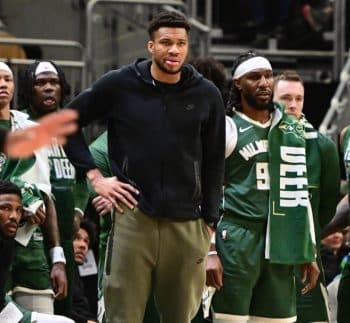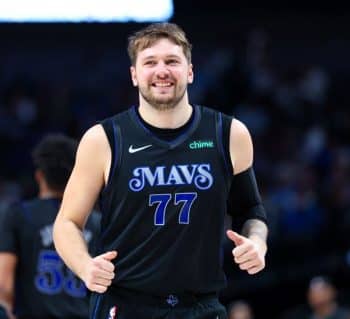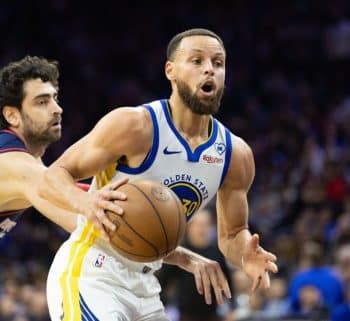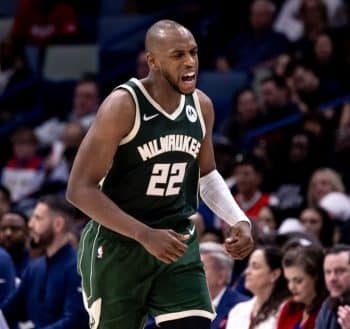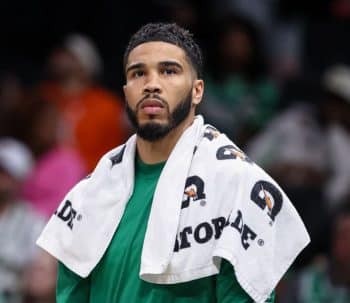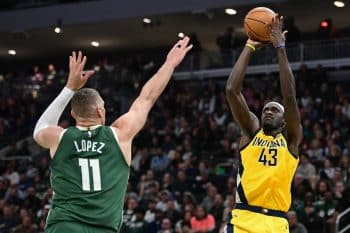NBA
NBA PM: Rudy Gobert is Ahead of Schedule

Rudy Gobert is Way Ahead of Schedule
The 2013 NBA Draft Combine in Chicago was supposed to provide NBA reporters their first opportunity to talk to French big man prospect Rudy Gobert. There was just one problem – they weren’t that interested. Gobert spent most of his media session sitting alone at his designated table.
The horde of reporters surrounded the draft’s other big men prospects such as Nerlens Noel and Cody Zeller, who were far more recognizable since they had starred at top college programs and appeared on national television. Gobert entered the draft largely unknown after playing in France for the Cholet Basket club. When people spot Gobert, they often stare since he’s 7’2 with a 7’8.5 wingspan and 9’7 standing reach. This is understandable, as Gobert looks like an NBA 2K created player who was set to the maximum dimensions and then somehow found a way to escape the video game and enter the real world. Even still, the reporters barely seemed to notice him.
While Noel and Zeller were expected to be top picks, Gobert was projected to go late in the first round and was viewed as a boom-or-bust prospect. He had the physical tools and potential to turn into an elite big man, but there were enough question marks surrounding him that some executives wondered if he would join the long list of seven-footers who entered the league because of their height, but weren’t talented enough to stick around long-term.
Gobert sat patiently and looked around, taking in the combine scene. There was the main court where players did drills and auditioned for the pack of executives, coaches and scouts. There was a station where the players’ athleticism was tested (such as their vertical leap and lane agility speed). There was a bench-press area. There was a place where players were measured to determine their height, wingspan, hand size, body fat percentage and more.
Then, there was the media area, where Gobert sat by himself. The tables and chairs in the media area were relatively large to accommodate the draft prospects. However, Gobert is so big that he looked like an adult sitting at a kid’s Fisher Price table.
Gobert seemed very self-aware during the pre-draft process. He acknowledged that he was a raw player who needed time to develop, specifically improving his strength, post moves and shot. He was looking forward to facing NBA competition, but admitted that without bulking up he would be “run over” by the league’s centers. He compared himself to Tyson Chandler, another defensive-minded NBA center who needed a few years to develop before realizing his potential and breaking out. Even though Gobert was honest about his weaknesses, he also exuded confidence. The Frenchman felt like he could eventually be an elite center, especially on the defensive end. He was determined to be great.
The few reporters who did speak to Gobert that day shook his hand after the media session ended, and felt like preschoolers shaking the hand of an adult. His hands are some of the largest measured in the history of the NBA combine, at 9.75 inches long and 10 inches wide. He stood up, towered over everyone in the room and left – with many onlookers staring straight up toward the sky to watch him exit the media area.
Several months later, Gobert was drafted 27th overall by the Denver Nuggets and immediately traded to the Utah Jazz in exchange for a second-round pick and cash. He was the ninth center selected in the draft. Jazz general manager Dennis Lindsey said that the team had high hopes for Gobert and loved his potential. With that said, it was believed that he was a project who would need several years on a development plan before he could be a significant contributor in an NBA rotation.
His rookie season with the Jazz seemed to confirm this assessment, as he averaged just 2.3 points, 3.4 rebounds, .9 blocks and 1.3 fouls in just 9.6 minutes per game. Some of his struggles could be attributed to his lack of minutes under head coach Ty Corbin, but he wasn’t very effective even when he was on the floor (often fouling excessively and looking out of place). This wasn’t a surprise, as he was supposed to be a work in progress.
Then, a crazy thing happened: Gobert started breaking out well ahead of schedule and playing at a high level in just his second NBA season. It began when he participated in the FIBA World Cup and with the France national team, which furthered his development and increased his confidence. He had a number of solid performances and helped the France win the bronze medal. Entering the season, he was ready to take on a bigger role with the Jazz and had made a number of improvements.
He bulked up over the summer, adding over 10 pounds to his 7’2 frame. He worked hard to improve his post moves and passing, since he would often be facilitating from the elbows in new head coach Quin Snyder’s system. His increased confidence led to him playing with more intensity, which is what the Jazz wanted to see from their big man prospect. Growing up, Gobert loved to box (imagine how terrifying it’d be to face him in the ring with that reach) and that aggressiveness is now on display during games. He also improved his decision-making and looked much more comfortable on the floor as a result.
This season, his growth has been stunning since he has gotten so much better in such a short period of time. On the season, he’s averaging 6.7 points on 67 percent shooting from the field, 7.2 rebounds and 2.2 blocks in just 21.5 minutes. His free throw percentage has also improved from 49.2 percent to 67.3 percent (which is more in line with his past free throw shooting since he shot nearly 70 percent from the charity stripe in France, suggesting his rookie struggles from the line were likely a byproduct of inconsistent opportunities).
Recently, Enes Kanter was sidelined with an ankle injury and Gobert was moved into the starting lineup. He took full advantage of this opportunity, as he averaged 9.5 points, 8.5 rebounds, 4.2 blocks, 1.4 assists and 1.3 steals in 34 minutes of action. He was dominant on the defensive end, swatting shots left and right and altering even more attempts at the rim.
Kanter has since returned to the starting lineup, but many people feel that Gobert should be starting for Utah since the team plays better when he’s given big minutes. When Gobert is on the court, Utah allows 100.7 points per 100 possessions (which would rank eighth in the NBA) versus 110.5 points allowed per 100 possessions when he’s off the court (which would rank last in the league).
Gobert has had a number of jaw-dropping outings this season. Against the San Antonio Spurs, he had 13 points, 18 rebounds, four blocks and two assists in 29 minutes. Against the Golden State Warriors, he had 16 points, 11 rebounds, four assists and three blocks. Against the Chicago Bulls, he had 11 points, 14 rebounds, two blocks and two steals. Against the Minnesota Timberwolves, he had 13 points, 11 rebounds and six blocks (including one quarter in which he had 11 points, five rebounds and five blocks).
“I thought that Gobert dominated inside,” Timberwolves head coach Flip Saunders said after that loss to the Jazz. “They got every loose ball that was out there. To me, that is what was disappointing, they beat us on energy plays and they ripped in and took our heart away.”
These are the kind of stat lines that fans have come to expect from Gobert when he’s given significant minutes, which is incredible considering he wasn’t even a reliable rotation player at this time last year. It’s also what the big man expects from himself. He strives for perfection during games. During halftime of a recent game, he was frustrated with himself because he allowed a few interior baskets. Even though he finished the game with a double-double and multiple blocks, he was still agitated.
“I wanted to make sure nobody scored in the paint,” Gobert said. “I didn’t want them to have any easy baskets.”
Bulking up over the offseason has helped him tremendously. The added muscle has allowed him to finish much better at the rim. He’s grabbing offensive rebounds and scoring off of putbacks, while also thriving as the roll man in pick-and-rolls. His shooting from 0-3 feet has increased from 58 percent (below league average) to an incredible 70 percent. His post-ups have been more successful this season as well (although there is still room for improvement). He’s averaging 1.045 points per possession, which puts him in the 89th percentile among all players in the NBA. He is becoming increasingly difficult to guard man-to-man, as he’s shooting 60.9 percent in those situations, which is in the 88th percentile.
While he has been better than expected offensively, he wants to continue to add to his offensive arsenal. He wants to enhance his repertoire of post moves and expand his offensive abilities further away from the basket too.
“I definitely want to develop a jump hook,” Gobert said. “I’ve started working on a 10-footer as well, but I haven’t had the confidence to shoot it in games. But it’s coming.”
Gobert’s defense obviously remains his biggest strength. His added muscle coupled with his frame has made him nearly impossible to score on in the post. Gobert ranks first in the NBA in points saved per game (2.64) and points saved per 36 minutes (4.47), according to NylonCalculus.com. In addition, he leads the league in block percentage (eight percent) and blocks per 48 minutes (4.91). Players shoot a league-low 37 percent against Gobert at the rim. This season, players are shooting just 30.5 percent against Gobert on post-ups, which puts him in the 90th percentile. In man-to-man defense, he’s limiting opponents to 34.6 percent from the field, which is also in the 90th percentile. When guarding the roll man on pick-and-rolls, he’s limiting their shooting percentage to 25 percent (in the 96th percentile).
“Rudy [is] amazing,” Gordon Hayward said. “It allows us to pressure then go for steals because we know if we miss, Rudy is there.”
He has also been very efficient this season, with a 21.6 Player Efficiency Rating that ranks 23rd in the league – putting him right around many of this year’s All-Stars and ahead of stars like Dirk Nowitzki, Jimmy Butler, John Wall, Chris Bosh and even Chandler, the center he once compared himself to. He’s seventh among all centers in Real Plus Minus, which estimates how many points a player adds or subtracts, on average, to his team’s net scoring margin for each 100 possessions played.
While Gobert’s blocks and dunks get most of the attention, his passing has been impressive as well. He has drastically improved as a passer and decision-maker, which has allowed him to handle the ball at the elbows at times and create for others. While he still has room to improve as a facilitator, he has made big strides this year – evident by his assist percentage increasing from 2.4 to 8.1. Many of his assists come from handing the ball off and screening a defender to give his teammate an open shot. However, he’s also very good at kicking out to perimeter shooters for three-point shots, sometimes off of drives or short rolls to the basket, and he’s solid at dishing to the big man playing alongside him for easy baskets at the rim. His passing skills are an underrated aspect of his game. His facilitating is encouraging for Utah’s future, as he should continue to improve this facet of his game. It could eventually allow Snyder to get even more creative with his offense. A 7’2 big with a 7’8.5’ wingspan is mainly looked at as a dunker and shot blocker, but he’s adding playmaker to his résumé lately.
“Rudy is a unique player,” Snyder said. “You can see that. You see it in spots. [When] we’re able to convert on his blocks, he changes the game. It’s something we know he can do. I think he’s learning to pick his spots more. He’s not fouling. He’s in a better position as well. When he doesn’t get a block, if he’s in a good position, he has a chance to change a shot. I think he’s involved in a lot more rebounds because he’s moving without the ball and not just hugged up to his man. He’s played very, very well.”
Not only is he putting up excellent numbers, it’s what he isn’t doing that helps Utah as well. He’s no longer fouling at a high rate (as Snyder mentioned), not missing nearly as many free throws, isn’t turning the ball over nearly as much and doesn’t seem passive on the court. The coaches say that his work ethic has drastically improved this season, which could also be a major factor in his growth.
While Gobert’s development has been way ahead of schedule, he’s not getting complacent. He’s continuing to work hard and is determined to expand his game.
“[I want to improve] pretty much everything,” Gobert said. “I want to stay on the court, I want to play without fouling and I want to keep making the right plays on both ends of the floor. … I just want to play the game. I want to get better on both sides of the floor and I want our team to win games. This is a learning process for all of us.”
The Jazz had some success playing Gobert alongside Derrick Favors when Kanter was injured, because both players are strong defenders who make it difficult for the opposition to score inside the paint.
“With Rudy and Favors out there, we use their athleticism and length,” Snyder said. “Also, [they make] a big difference out there on defense… The defensive intensity is something I see as respect for one another. When you see a teammate giving himself up for the team, you want to get in and do the same.”
Snyder also noted that the team defense has gotten much better recently, with the group coming together and gaining trust in one another. He said that every player knows that they can rely on their teammates to “have their back” on defense, which lines up with what Hayward said about Gobert essentially being the team’s safety net that can correct any mistakes made in front of him.
Gobert’s development has been astonishing since he’s playing at a level many thought he wouldn’t reach for several more years – if ever. And perhaps the scariest thing about Gobert is that he’s still just 22 years old, so his best basketball is almost certainly still ahead of him. This is just the tip of the iceberg in terms of his growth as a player. He’s the complete package as a big man, so it’s possible that he could become one of the league’s elite centers as he continues to realize his full potential in the coming years.
Gobert has arrived, and his days of sitting alone and going unnoticed are long gone.
Tony Jones from the Salt Lake Tribune contributed to reporting for this piece.
Kobe Bryant Will Have Surgery
Los Angeles Lakers guard Kobe Bryant, who injured his right shoulder in last Wednesday night’s game against the Pelicans in New Orleans, will have surgery on Wednesday to repair his torn rotator cuff.
The Lakers sent out a press release confirming the news of Bryant’s surgery.
Bryant had met with multiple doctors and had been weighing his options. He wanted to see if there was a way to avoid surgery and just go through rehab instead.
However, when he was examined this morning by Dr. Neal ElAttrache of the Kerlan Jobe Orthopaedic Clinic, Dr. ElAttrache advised Bryant to have surgery to repair the shoulder as well. With that, Bryant agreed, and scheduled the surgery for Wednesday morning.
The Lakers haven’t released a timetable for Bryant’s return, but he will miss the rest of the season due to the surgery. Some reports have indicated that it will take six months for him to recover fully.
Bryant has one more year on his contract with the Lakers, which will pay him $25 million if he plays next year.
